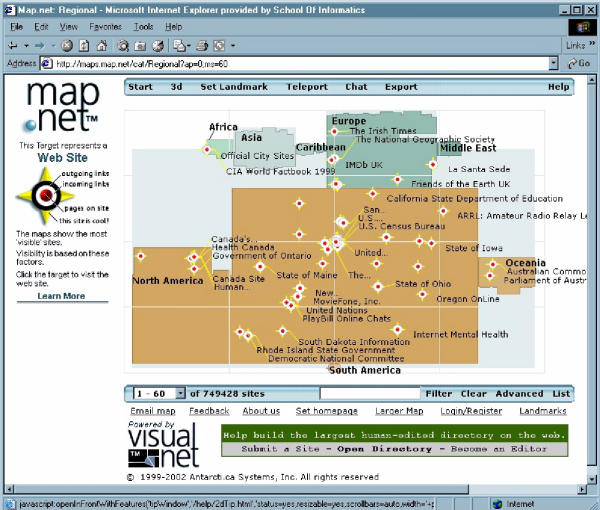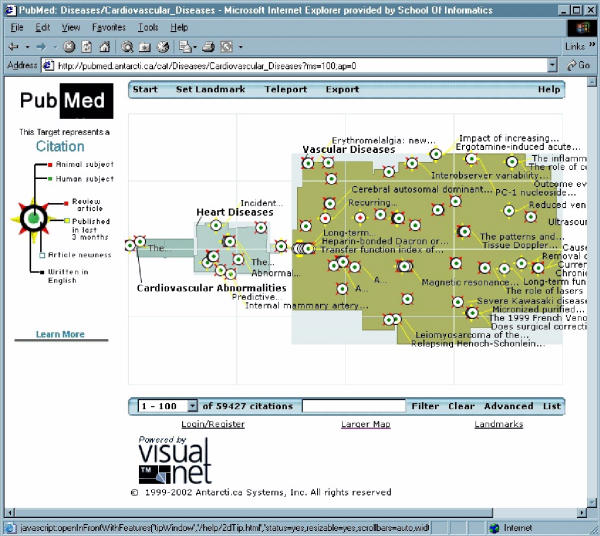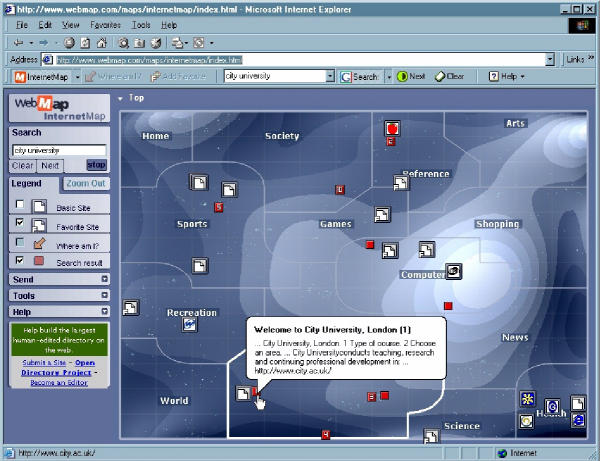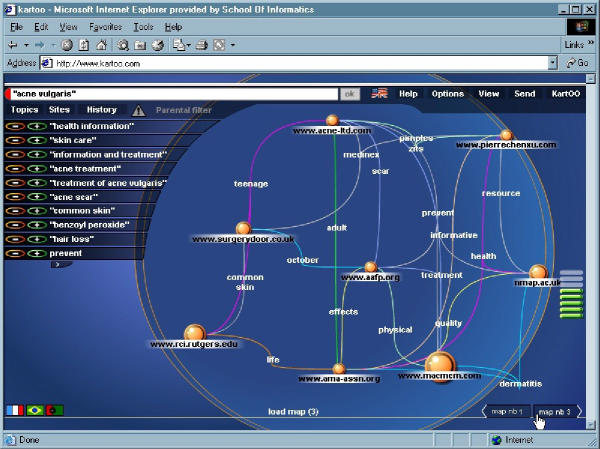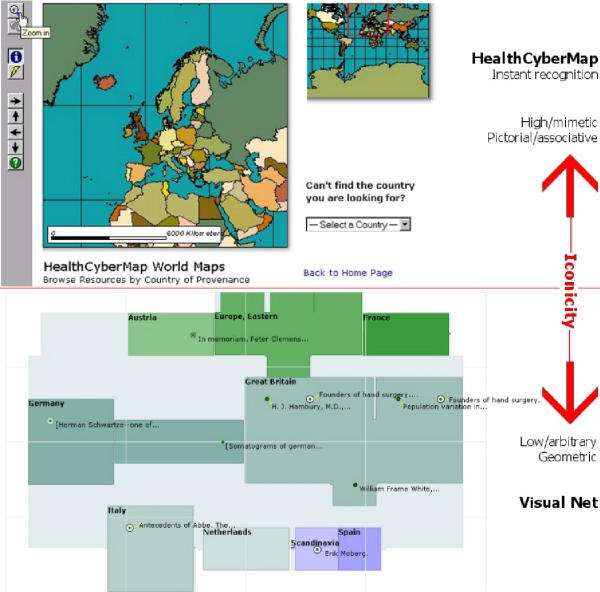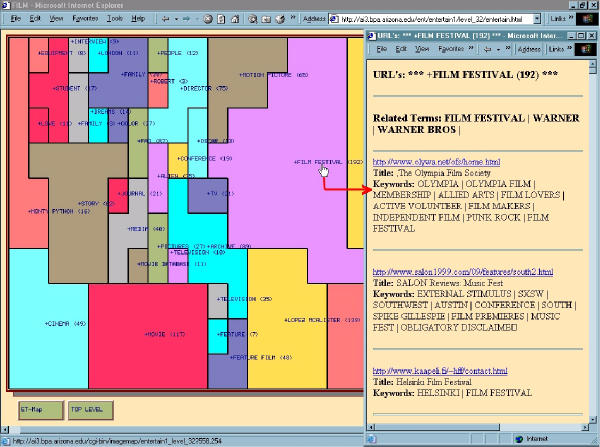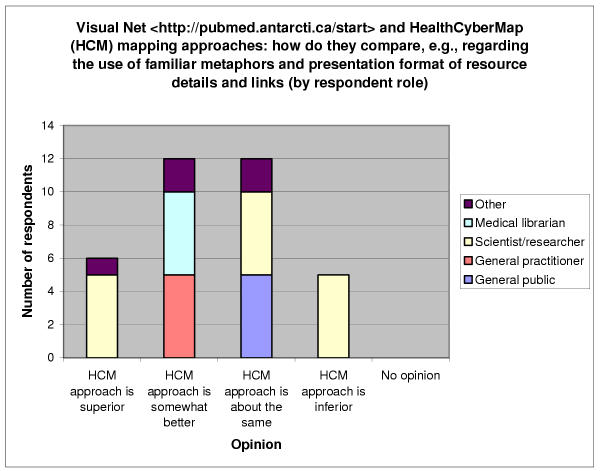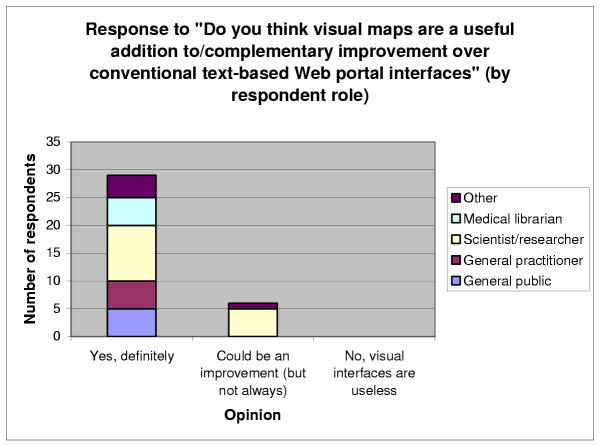Abstract
As online information portals accumulate metadata descriptions of Web resources, it becomes necessary to develop effective ways for visualising and navigating the resultant huge metadata repositories as well as the different semantic relationships and attributes of described Web resources. Graphical maps provide a good method to visualise, understand and navigate a world that is too large and complex to be seen directly like the Web. Several examples of maps designed as a navigational aid for Web resources are presented in this review with an emphasis on maps of medical and health-related resources. The latter include HealthCyberMap maps http://healthcybermap.semanticweb.org/, which can be classified as conceptual information space maps, and the very abstract and geometric Visual Net maps of PubMed http://map.net (for demos). Information resources can be also organised and navigated based on their geographic attributes. Some of the maps presented in this review use a Kohonen Self-Organising Map algorithm, and only HealthCyberMap uses a Geographic Information System to classify Web resource data and render the maps. Maps based on familiar metaphors taken from users' everyday life are much easier to understand. Associative and pictorial map icons that enable instant recognition and comprehension are preferred to geometric ones and are key to successful maps for browsing medical/health Internet information resources.
Introduction
The need for maps to navigate the Web
As online information portals and services accumulate metadata descriptions of Web resources, it becomes necessary to develop effective ways for visualising and navigating the resultant metadata repositories as well as the different semantic relationships and attributes of described Web resources.
Humans are able to navigate through geographic space thanks to their spatio-cognitive abilities, which have similar value in the exploration and understanding of non-geographic complex information spaces like the World Wide Web [1].
Maps are powerful graphic tools that classify, represent and communicate spatial and/or spatialised relations (non-spatial relations projected into some conceptual space for mapping [2,3]). Maps are also a method to visualise and navigate a world that is too large and complex to be seen directly. A map shows us more in less space, enabling us to plan our route in advance [4].
It has been said the Web is its own map [5]. But as we surf the Web, we can only appreciate a very small part of it at any given time. We cannot figure out the semantic relations of the page we are visiting to the rest of the Web, and cannot easily locate Web resources covering narrower, broader or similar topics as the one we are currently looking at [3]. We need a map or set of maps for this purpose.
When a spatialised Web information space is rendered in the form of an interactive (clickable) map, the spatial representation (map) becomes the territory and also the means in which to navigate this territory. Links on such map are not just a representation of corresponding Web resources, but can also directly launch (take users to) these resources. This is not true for conventional real world maps, which were never meant to be the territory; they just allow users to visualise land and routes, then users will need to drive along real-world streets (not the maps obviously) to physically reach their destination [5]. This paper critically reviews different types of maps designed as a navigational aid for Web resources with an emphasis on maps of medical and health-related resources.
A review of maps of Web resources
In their book "Atlas of Cyberspace" [6] and related Web site http://www.cybergeography.org/atlas/atlas.html, Martin Dodge and Rob Kitchin present at least fifteen categories of cybermaps (maps of Internet resources and structures), some of them with apparently overlapping scopes. Two of these categories are very relevant to this paper, namely information space maps and information landscapes.
Information space maps represent Internet information spaces as two-dimensional maps using sophisticated information indexing and classification methods, e.g., a topical hierarchy of resources (cf. conventional landuse maps used in city planning). Information landscapes represent Internet information spaces as three-dimensional (3D) landscapes. The aim of these two types of maps is to give users a sense of the mapped information domains and to assist searching and information retrieval.
Information space maps
Some examples of maps belonging to this group are presented below and include, Visual Net (http://map.net/start and http://map.net – Figures 1 and 2), WebMap (http://www.webmap.com/ – the public InternetMap demo is no longer available – Figure 3), Kartoo (http://www.kartoo.com/ – Figure 4) and HealthCyberMap (http://healthcybermap.semanticweb.org/ – Figure 7 – [3,7]).
Figure 1.
Screenshot of a Map.Net map. This Map.Net map http://maps.map.net/cat/Regional?ap=0;ms=60 is supposed to be a regional category map of Web resources, but because it uses an ad hoc representation, some users might be lost, finding that Caribbean resources now lie between Asia and Europe, and above North America! Relative (geographic) position is not preserved in this representation for a topic that is explicitly geographical (continents/regions of the world).
Figure 2.
Screenshot of a map from Visual Net PubMed interface. Screenshot of a map from Visual Net PubMed interface http://pubmed.antarcti.ca/cat/Diseases/Cardiovascular_Diseases?ms=100;ap=0. The map appears overcrowded with overlapping citation symbols and their incomplete labels.
Figure 3.
Screenshot of WebMap's InternetMap. WebMap's InternetMap (previously available from http://www.webmap.com/maps/internetmap/index.htm) is an interactive, hierarchical visual directory that maps over two million categorised Web sites from the Open Directory Project http://dmoz.com/. WebMap is a browser plug-in that represents hierarchical categories as irregular shaped polygons or territories. A smooth zoom brings more detailed categories into view. Each of these territories contains a different subject category. Within each territory, individual Web sites are shown by small mountain symbols and related sites are positioned close to one another. The concentric blue-coloured shapes represent WebMap's topography. The lighter areas are "peaks", while the dark blue areas are "valleys". With this topography, WebMap visually differentiates between sites. Sites that experience more traffic are placed higher on the topographic scale.
Figure 4.
Screenshot of Kartoo. Kartoo http://www.kartoo.com/ is a cartographic, visual meta-search engine that relies on the network metaphor as a visual interface to results pooled from external search engines. The cartographic interface of Kartoo uses Macromedia Flash. Labels of links between map nodes attempt to give an idea about the kind of relationship between two connected nodes (sites), but are very frequently confusing and incorrect.
Figure 7.
Screenshot of HealthCyberMap's BodyViewer Maps. Screenshot of HealthCyberMap's GIS-driven BodyViewer Maps on the Web http://healthcybermap.semanticweb.org/bodyviewer/. These hierarchical human body topical maps with semantic zoom can be used to visually browse selected medical/health resources on the Web by clinical subject. Body organs with darker red tints have more resources associated with them than organs with lighter red shades (choropleth rendition); a grey colour denotes no resources. The resources have been categorised and spatialised to the different human body organs on the map according to a clinical coding scheme. Their metadata are displayed in a separate pop-up text window (map query result page) to avoid map clutter. The latter would have been unavoidable had the author opted to represent each resource using a distinct point symbol on the map (cf. Visual Net approach – Figure 2).
Visual Net
Visual Net mapping technology has been developed by Antarcti.ca http://antarcti.ca/ and aims at rendering computer networks in the form of 2D and 3D maps. Antarcti.ca used Visual Net technology in Map.Net http://map.net/start – (Figures 1 and 12) to provide multilevel (hierarchical/categorical) information maps for browsing over two million Web sites from the Open Directory Project http://dmoz.com/. Rather than using conventional search engine technology to navigate the Web (or indeed any other hierarchical information space), Visual Net creates a landscape that spatially represents relationships between data, though in a very abstract, geometric fashion. Antarcti.ca also applied Visual Net technology to PubMed, the US National Library of Medicine (NLM) well-known database of citations (http://map.net – Figure 2 – see also Figures 8 and 9).
Figure 12.
Screenshot showing some UK health resources in Map.Net 3D. Screenshot showing some UK health resources in Map.Net 3D http://map.net/start. Users are essentially "walking" on the ground, among buildings that represent Web sites. Map.Net 3D requires a special plug-in to be downloaded and installed first.
Figure 8.
Screenshot of parts of HealthCyberMap and Visual Net navigational maps for "heart diseases". Screenshot of parts of HealthCyberMap and Visual Net navigational maps for "heart diseases". Notice the difference in map iconicity between HealthCyberMap and Visual Net approaches, and the map clutter resulting from Visual Net's way of representing each resource directly on the map using a distinct point symbol.
Figure 9.
Screenshot of parts of HealthCyberMap and Visual Net navigational maps for "countries of Europe". Screenshot of parts of HealthCyberMap and Visual Net navigational maps for "geographical places (countries of Europe)". Notice the difference in map iconicity between HealthCyberMap and Visual Net approaches, and how "Great Britain" is oddly mapped (and shaped) east of "Germany" on Visual Net map.
Self-organising maps
Self-organising maps of Internet information spaces are also classified under this category of information space maps. Girardin [8] describes a Web resource mapping approach using Kohonen Self-Organising Maps (SOM). The self-organising map algorithm is an unsupervised neural network composed of an input layer and a competitive/output neural layer. The most interesting property of this network is that the feature map preserves the topology of stimuli according to their similarity. Other related self-organising Web maps, include ET-Map at the University of Arizona (http://ai2.bpa.arizona.edu/ent/entertain1/ – Figure 5) and WEBSOM at Helsinki University of Technology http://websom.hut.fi/websom/. The latter has been used to map collections of Usenet newsgroups. SOM neural net output is sometimes semantically confusing. The flat landuse visualisation of ET-Map is also semantically poor compared to other forms of classification and visualisation.
Figure 5.
Screenshot of ET-Map. http://ai3.bpa.arizona.edu/ent/entertain1/level_32/entertain.html, a hierarchical category map set representing over 100,000 entertainment-related Web pages listed by Yahoo! ET-Map has been developed by researchers at the Artificial Intelligence Lab, University of Arizona, US.
Geographic maps
Information resources can be also organised and navigated based on their geographic attributes, e.g., geographic scope of resource content or location of the hosting server or author(s)/publisher(s). These geographic aspects of information resources are sometimes very useful as an index to information resources [9,10]. An example of such maps is the UK Academic Map, maintained by the University of Wolverhampton, UK, which went online in 1994 (Figure 6). Sites are shown on the map as dots, which act as hotlinks to the different Web sites of the academic institutions in the UK. However, by using a separate map symbol (dot) for each mapped Web site, symbols quickly become cluttered as many Web sites are obviously clustered in large cities that cover a relatively small geographic (and map) area in relation to the amount of information they contain [11].
Figure 6.
Screenshot of the University of Wolverhampton UK academic sensitive map. Screenshot of the University of Wolverhampton UK academic sensitive map http://www.scit.wlv.ac.uk/ukinfo/uk.map.html. The "Library" topic was selected (yellow left pane) and "Dundee" clicked to launch "Dundee University Library and Information Services" Web site.
HealthCyberMap's GIS-driven maps
The conventional use of GIS (Geographic Information Systems) to analyse and map real-world health and healthcare data is well documented in the scientific literature [12]. However, research literature on the use of GIS to map semantic (information) spaces is scarce and includes the work done by Old [13] and Terpstra [14]. None of the map examples presented in this paper uses GIS except HealthCyberMap [7].
HealthCyberMap pilot service http://healthcybermap.semanticweb.org/ currently provides six different interfaces to its metadata base, which has over 1600 resource records in it. Some of these interfaces are visual (maps for browsing resources by clinical/health topic, by provenance and by type), while others are textual (e.g., a Semantic Subject Search Engine and directory of topical categories) [3].
HealthCyberMap features a novel and unique methodology that brings together a Geographic Information System (GIS) and a clinical coding scheme for the first time for the purpose of classifying and mapping conceptual spaces occupied by collections of medical/health Internet information resources based on their topics and other metadata attributes.
Geographic Information Systems are robust and reliable tools, optimised for handling, cross-linking and visualising data with spatial and/or spatialised components. In GIS, data semantics and visualisation are separated for maximum flexibility, but remain tightly coupled, which corresponds to HealthCyberMap's core architecture model, making GIS a perfect choice as a classification and visualisation engine.
The clinical coding scheme provides a conceptual semantic space that GIS projects on graphical maps of the human body and its organs. GIS then maps selected medical/health Internet resources to different semantic locations in this conceptual space (and corresponding human body maps) according to the semantics of resource topics.
The conventional geographic map metric of distance translates well into a new "semantic distance" metric on HealthCyberMap's human body maps. The "semantic distance" between two resources on these maps depends on how close (or related) the two resources are from a semantic perspective (i.e., their semantic proximity based on their medical/health topics as determined by the underlying clinical coding scheme which preserves the semantic relations between topics). For example, a resource on "myocardial infarction" will be much closer to a resource on "angina pectoris" than to another resource on "psoriasis".
The resultant graphical hypermaps build on humans' spatio-cognitive abilities and the familiar human body metaphor to provide a highly meaningful way for browsing and visually querying large collections of medical/health Internet resources (Figure 7). HealthCyberMap human body maps adopt a semantic zooming approach. With a conventional geometric zoom all objects change only their size; with semantic zoom they can additionally change shape, details (not merely size of existing details) or, indeed, their very presence in the display, with objects appearing/disappearing according to the context of the map at hand [3,15].
GIS also classifies information resource counts per body region into ranges and associates each range with a colour shade or tint on HealthCyberMap's human body maps (i.e., a choropleth rendition – Figure 7). This allows map users to visually spot "infogaps" (topical coverage gaps to be addressed by information providers) [3].
HealthCyberMap vs. Visual Net
A formative evaluation study of HealthCyberMap pilot service using an online user evaluation questionnaire, in addition to analysis of HealthCyberMap server transaction log, has been conducted during the period from 18 April 2002 to 1 June 2002. The questionnaire included a comparative task (http://healthcybermap.semanticweb.org/questionnaire.asp – question 34) to learn how users perceive the difference between HealthCyberMap and Visual Net, especially regarding map iconicity (high/associative and pictorial in HealthCyberMap vs. low/geometric in Visual Net – Figures 8 and 9) [16]. Based on Nielsen's well-known usability criterion of "recognition not recall" [17], associative and pictorial icons that enable instant recognition/comprehension should be preferred to geometric ones.
Thirty-five subjects responded to HealthCyberMap online evaluation questionnaire during the 45-day evaluation period. Eighteen of them (51.4%) found HealthCyberMap approach to be either "superior" or "somewhat better" than that of Visual Net. Twelve subjects (34.3%) found both approaches to be about the same, while only 5 respondents (14.3%) felt HealthCyberMap approach is inferior (Figure 10) [18].
Figure 10.
HealthCyberMap vs. Visual Net comparative task results. HealthCyberMap vs. Visual Net comparative task results (by respondent role – HealthCyberMap evaluation questionnaire results).
It is noteworthy that the same questionnaire included another question on users' attitude towards visual maps as a navigational aid for medical and health-related Internet resources ("Do you think visual maps are a useful addition to/complementary improvement over conventional text-based Web portal interfaces"). Most respondents (29 – 82.86%) selected "Yes, definitely" in response to this question. The remaining 6 subjects (17.14%) chose "Could be an improvement (but not always)" in response to the same question. The answer "No, visual interfaces are useless" was not selected by any respondent, so one can assume that all respondents generally had a positive and welcoming attitude towards visual maps as one useful form of Web portal interfaces (Figure 11) [18].
Figure 11.
Users' attitude towards visual maps as navigational aid. Users' attitude towards visual maps as navigational aid (by respondent role – HealthCyberMap evaluation questionnaire results).
Three-dimensional information landscapes
The 3D-cityscape view of the Web generated by Visual Net's Map.Net (Figure 12) is one example of such maps. It allows the user to fly-through the Web, with individual Web sites represented by different buildings. The large skyscrapers are the most popular and important sites on the Web. Another example of 3D information landscapes is StarWalker [19] – Figure 13.
Figure 13.
Screenshot of StarWalker interface. StarWalker interface (previously available from http://www.brunel.ac.uk/~cssrccc2/vrml2/starwalker/. The linked stars are icons representing papers from three years conference proceedings (1995–1997) of ACM CHI (Association for Computing Machinery – Special Interest Group on Computer-Human Interaction). When the user clicks one of these icons, the full text version of the corresponding paper appears in the right frame. Links between spheres indicate that the corresponding papers have salient semantic connections as derived through a Generalised Similarity Analysis modelling procedure, which is used to build the semantic space that is then rendered into a Virtual Reality (VR) model in VRML (Virtual Reality Modelling Language). Vertical bars in red are some papers concerning social interaction and discourse structures in the context of Human-Computer Interaction. Users can move around within this VRML-based virtual world, e.g., walk, fly, etc. StarWalker does not tell the user what resource a star is pointing to until the star is actually clicked and the resource loaded (a major shortcoming). Also, there is no map legend, but the developers of StarWalker mention that articles (stars) are colour-coded by the year of publication [19].
Andrews [20] argues that visual representation of information spaces using technologies like Visual Net, although appealing, is unwieldy as a navigation method. He mentions that people usually complained of technical limitations, vertigo and confusion when presented with fly-through metaphors for data navigation. He believes that systems intended for casual or untrained Web surfers will likely have the best chance of success by focusing on increased simplicity, involving universal iconography on the order of road signs, not new dimensions of navigation.
Conclusions
As online information services accumulate metadata descriptions of Web resources, it becomes necessary to develop effective ways for visualising and navigating the resultant huge metadata repositories as well as the different semantic relationships and attributes of described Web resources. Graphical maps provide a good method to visualise, understand and navigate a world that is too large and complex to be seen directly like the Web. At least fifteen categories of cybermaps have been described in the literature, of them information space maps and information landscapes are the two categories most relevant to this review. Several examples of maps designed as a navigational aid for Web resources have been presented with an emphasis on maps of medical and health-related resources. The latter include HealthCyberMap maps http://healthcybermap.semanticweb.org/, which can be classified as conceptual information space maps, and the very abstract and geometric Visual Net maps of PubMed http://map.net. Information resources can be also organised and navigated based on their geographic attributes.
Some of the maps presented in this review use a Kohonen Self-Organising Map algorithm (SOM, an unsupervised neural network). None of the map examples described in this paper uses GIS to classify Web resource data and render the maps, except HealthCyberMap.
Maps based on familiar metaphors taken from users' everyday life are much easier to understand. The human body is an excellent example of a familiar metaphor that can be used for the topical browsing of medical/health Internet resources as demonstrated in HealthCyberMap. Indeed, whenever medicine or health are mentioned we nearly always remember our bodies. Associative and pictorial map icons that enable instant recognition/comprehension are preferred to geometric ones and are key to successful maps for browsing medical/health Internet information resources.
References
- Skupin A. From Metaphor to Method: Cartographic Perspectives on Information Visualization. In Proceedings of IEEE Symposium on Information Vizualization (InfoVis): Salt Lake City, Utah. 2000 October http://www.geog.ucsb.edu/~sara/teaching/geo234/papers/skupin.pdf and http://www.geog.uno.edu/~askupin/research/infovis2000/figures/
- Dodge M, Kitchin R. Mapping Cyberspace. London, Routledge. 2001.
- Kamel Boulos MN, Roudsari AV, Carson ER. HealthCyberMap: A Semantic Visual Browser of Medical Internet Resources Based on Clinical Codes and the Human Body Metaphor. Health Info Libr J. 2002;19:189–200. doi: 10.1046/j.1471-1842.2002.t01-1-00397.x. [DOI] [PubMed] [Google Scholar]
- Kraak MJ, Brown A. Web Cartography: Developments and Prospects. London, Taylor & Francis. 2001.
- Staple GC. Notes on Mapping the Net: From Tribal Space to Corporate Space. In: Staple GC, editor. In TeleGeography 1995: Global Traffic Statistics & Commentary. Washington, DC, TeleGeography, Inc; 1995. pp. 66–73. [Google Scholar]
- Dodge M, Kitchin R. Atlas of Cyberspace. Harlow, England, Addison Wesley. 2001. http://www.cybergeography.org/atlas/atlas.html
- Kamel Boulos MN, Roudsari AV, Carson ER. A simple method for serving Web hypermaps with dynamic database drill-down. Int J Health Geogr. 2002;1:1. doi: 10.1186/1476-072X-1-1. http://www.ij-healthgeographics.com/content/pdf/1476-072X-1-1.pdf [DOI] [PMC free article] [PubMed] [Google Scholar]
- Girardin L. Mapping the virtual geography of the World-Wide Web. In Proceedings of the 5th International World Wide Web Conference: Paris, France. http://www.girardin.org/luc//cgv/www5/index.html 1996 May.
- Ding J, Gravano L, Shivakumar N. Computing Geographical Scopes of Web Resources. In Proceedings of the 26th Very-Large Database (VLDB) Conference: Cairo, Egypt. http://www.cs.columbia.edu/%7Egravano/Papers/2000/vldb00.pdf 2000 September.
- Tutarel O. Geographical distribution of publications in the field of medical education. BMC Med Educ. 2002;2:3. doi: 10.1186/1472-6920-2-3. http://www.biomedcentral.com/1472-6920/2/3/ [DOI] [PMC free article] [PubMed] [Google Scholar]
- Dodge M. Indexing the Web with Geography. MappaMundi Magazine – Map of the Month. http://mappa.mundi.net/maps/maps_017/ 2000 Nov 1.
- Kamel Boulos MN, Roudsari AV, Carson ER. Health Geomatics: An Enabling Suite of Technologies in Health and Healthcare (Methodolical Review). J Biomed Inform. 2001;34:195–219. doi: 10.1006/jbin.2001.1015. [DOI] [PubMed] [Google Scholar]
- Old LJ. Web Access to Non-spatial Data using Internet Map Servers. In Proceedings of the 21st Annual ESRI International User Conference: San Diego, California. http://gis.esri.com/library/userconf/proc01/professional/papers/pap237/p237.htm 2001 July.
- Terpstra P. Mapping Cyberspace with GIS. In Proceedings of the 18th Annual ESRI International User Conference: San Diego, California. http://gis.esri.com/library/userconf/proc98/PROCEED/TO650/PAP615/P615.HTM 1998 July.
- Spence R. Information Visualization. Essex, ACM Press. 2001.
- MacEachren AM. How Maps Work: Representation, Visualization, and Design. New York, The Guilford Press. 1995. pp. 256–266.
- Nielsen J. Heuristic Evaluation. In: Nielsen J, Mack RL, editor. In Usability Inspection Methods. New York, John Wiley & Sons, Inc; 1994. pp. 25–62. [Google Scholar]
- Kamel Boulos MN. HealthCyberMap: Mapping the Health Cyberspace Using Hypermedia GIS and Clinical Codes (PhD Thesis). City University, Centre for Measurement and Information in Medicine (MIM), London, UK. http://healthcybermap.org/publications/KamelBoulos_final_PhD_thesis.pdf December 2002.
- Chen C, Thomas L, Cole J, Chennawasin C. Representing the Semantics of Virtual Spaces. IEEE Multimedia. 1999;6:54–63. doi: 10.1109/93.771373. [DOI] [Google Scholar]
- Andrews W. Commentary: 3D visualization may succeed in some systems. Tech News – CNETcom. http://news.cnet.com/news/0-1005-200-3681261.html 2000 Nov 14.



